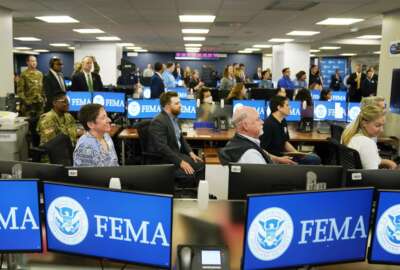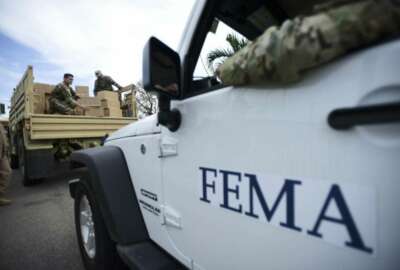Wild fires in the western forests aren’t the only burning issues for FEMA
House fires remain the most common form of fire each year, and FEMA keeps close track of them. With some recent statistics and how the agency gathers it, acting...
Best listening experience is on Chrome, Firefox or Safari. Subscribe to Federal Drive’s daily audio interviews on Apple Podcasts or PodcastOne.
The western wild fires have caused a lot of headaches for agencies like FEMA who must respond. But house fires remain the most common form of fire each year, and FEMA keeps close track on house fires too. With some recent statistics and how the agency gathers it, the acting U.S. Fire Administrator, Tonya Hoover, joined Federal Drive with Tom Temin.
Interview transcript:
Tom Temin: Ms. Hoover, good to have you on.
Tonya Hoover: Thank you so much. It’s a pleasure and an honor to be with you.
Tom Temin: Now the fire administration is not the responder here, but you do kind of follow what’s going on with the federal response. Just give us before we get to the house fire question, what is the status of wildfires at this moment?
Tonya Hoover: The status of wildfires across the country, we still have active burning, we keep close tabs on that because of our relationship with our state, local, tribal and territorial partners, and being an advocate for local government and state government fire services. But I can tell you based on information coming out of the national wildland fire preparedness or out of what we call the National Interagency Fire Center, we are at preparedness level two right now, that is somewhat of a good sign in that we were at the highest level of a five. And over the last month, we’ve been able to reduce that, or they’ve been able to reduce that to a two. But that still means that there are more large wildfires burning throughout the country, which are requiring resources to mobilize in different areas. So basically, we are still pulling resources from all over the country to address wildfires, not just on the west coast, but throughout the US.
Tom Temin: Well, let’s hope they all have a good rainy season and very soon. And just a detailed question as we get to the statistics that FEMA and your agency keeps on house fires. If a wildfire burns a house does not get counted in the house fire count?
Tonya Hoover: It can be counted. And so this is where the teed to do an in depth analysis on information that is being provided to what we call our National Fire Incident Reporting System, where we come in when we gather that information from our state and local partners, look at that so that we’re not double counting information.
Tom Temin: Sure, because anytime something happens, 27 people now with cell phones call 911. So a lot of incidents seem to happen many many times. Tell us how the data is collected on house fires by the fire administration.
Tonya Hoover: Data is collected on house buyers using our National Fire Incident Reporting System, which is commonly called NFIRS. And NFIRS is a collection standard. So in other words, it provides an opportunity for information coming in, apples or apples and oranges or oranges, as we like to say. But that information actually comes from our state and local partners. So there are a couple ways that we get information into the NFIRS system. We do have jurisdictions that will take their input, run information or their response information and directly put that into the NFIRS system. But most commonly, local government will upload their response information into their state system. And that state system then uploads into the federal system. And first, it’s not USFA information, it’s actually information coming from local government, to the federal government.
Tom Temin: And you mentioned that it’s a reporting standard so that the causes, the amount of damage, any fatalities or injuries – everyone’s reporting common information. Is that fair to say?
Tonya Hoover: Yes, that’s the intent. Now, keeping in mind that there are over 24,000 fire departments that report into NFIRS, that’s great numbers. We think we can always do better. I’m pretty sure there’s probably more than 24,000 fire departments. So when someone does their reporting, and they are using coding to report certain things, we want to make sure that we’re educating people about the correct codes to use when they’re inputting their information into the NFIRS system.
Tom Temin: We’re speaking with Tonya Hoover, she’s the acting US fire administrator, and the overall agency there is FEMA. What are the trends in house fires? What kinds of trends do you look for? And does the quality and location and cause of fires change over time?
Tonya Hoover: Yes, they do. And we constantly study trends. It is part of that data driven decision making that’s so critical to our program areas. So we want to keep a count on trends and take deep dives. So from when we look at a 10 year period from 2010 to 2019, because 2019 is our current total data collection, we’re still receiving information for 2020. We have a 10 year trend of residential fires that are showing less than 1% decrease in fires with a 14% increase in deaths. So what does that mean? Well, we’re seeing a decrease in fires, a small decrease in fires, but there’s another part of that story. And that other part is we’re seeing an increase in deaths. And in 2018 and 19, there were several multi fatality fires that can very well contribute to that overall increase. That’s why it’s important to do a deep analysis of the data coming in. We’re also seeing a 16% decrease in injuries. That’s good. But we’re seeing a 6% increase in dollar losses as that’s adjusted to 2019 dollars.
Tom Temin: Sure, so the increase in fatalities would at first glance maybe seem to say that there are more multifamily house fires,. The fatal fires tend to be in multifamily dwellings?
Tonya Hoover: It could say that, but what we believe it saying is that we are seeing more multifatality fires. So it could very well be a single family, with multiple people in the structure. That’s why the deep dive into that information is really important. What does it really tell us? But what folks want to grab hold of is that, well, you’ve got a decrease in fires. That’s true. And we’re doing a really good job with children fire fatalities. But we’re seeing a large increase in our elderly population, and also an increase in elderly population for injuries. But again, that deep dive tells us that we’re having more multi fatality fires going on, and so we want to track that closely.
Tom Temin: And what about the causes of residential fires>
Tonya Hoover: Causes in residential fires, what we’re seeing is that cooking, 31%, is still the leading cause of residential fires resulting in injuries. We have been talking about cooking fires for years. And the reason why we stay focused on cooking fires is because the data consistently shows us that cooking in the reports that we’re receiving is still the leading cause of those residential fires.
Tom Temin: I imagine over time, this data then can be used, it’s gathered nationally, federally, but I imagine local fire departments can use it to inform their kinds of prevention mechanisms, the outreach they do to the public, to make sure they can have some control over what’s going on.
Tonya Hoover: Absolutely. I mentioned earlier about data driven decisions. And at the federal level, we use it for program analysis, we use it to inform our federal partners and also inform the legislature. But at a local and state level, that information gets used when helping set priorities and targeting resources for designing, as you mentioned, programs, educational programs, tracking EMS activities, trying to address those real emergency problems at a local level. And it goes back to as a community looks at their community risk reduction, and actually to really understand community risk, that’s all within the data. So that’s used heavily by local government at a state level. Of course, the states can use this for legislature, they also use it to justify budgets and to pass the important bills that are fire related anywhere from arson to fireworks to residential sprinkler systems.
Tom Temin: Sure. And by the way, how many fires are attributed to arson?
Tonya Hoover: Well, I can tell you from 2017 to 2019, in the data that we’ve collected, intentional fires, those fires that we know were set, percentage of residential building fires resulting in injuries with cause determined, it’s at 5.7%. Under investigation, 4.1%. So under investigation can’t really say that they’re intentional yet, they’re still being investigated. But those intentional fires are sitting at about 6%.
Tom Temin: And by the way, what is the total number of fires in that 10 year period?
Tonya Hoover: Total number of fires in the 10 year period, there were 7,200 residential building fires resulting in injuries.
Tom Temin: But if cooking results in the most fires, then there’s the implication that electrical wiring, heating systems are generally pretty good. And almost like in the airline industry, it’s operator error that is the biggest cause.
Tonya Hoover: We find that in the world of electrical, we’ve gotten much better. I can go back and remember, well I don’t remember but I remember reading, when we started using electricity, many, many, many, many, many moons ago. Electricity was going to be the root of all evil. And yes, there have been electrical problems, there have been electrical fires. There are things that happen, people rewire, are not educated on electricity, how to rewire or do different things, and that can lead to problems, to fires. But we’re seeing that cooking is still that leading cause
Tom Temin: Al right. And houses don’t have fuses anymore that you can put a penny in to get around the fuse and then cause a fire, so maybe that’s a good thing.
Tonya Hoover: You look at electrical malfunctions, for example, causes of residential fires resulting from injuries, we’ll use that one as an example, electrical malfunctions, percentage of residential fires resulting from injuries, 7.1%. So it’s not high on the list. Cooking still is the highest on the list.
Tom Temin: Sure. I guess it also says that if you want to do some wiring, probably hire an electrician.
Tonya Hoover: Well, it’s always better to be safe than sorry, and absolutely there are professionals that do this that are trained, are well educated in working with, whether it be electrical or plumbing or gas lines, hire the professional. We hope they know what they’re doing. Most of them are licensed to do this work, which means they’ve been trained in the business.
Tom Temin: Tonya Hoover is acting US fire administrator at FEMA. Thanks so much.
Tonya Hoover: It was great to speak with you and I encourage anyone if they want information on fire safety, reducing risk from fires and other hazards, please visit our website.
Copyright © 2024 Federal News Network. All rights reserved. This website is not intended for users located within the European Economic Area.
Tom Temin is host of the Federal Drive and has been providing insight on federal technology and management issues for more than 30 years.
Follow @tteminWFED






